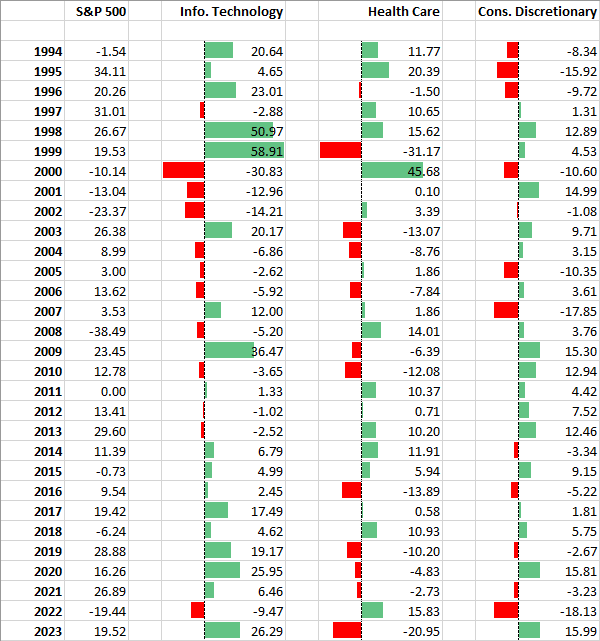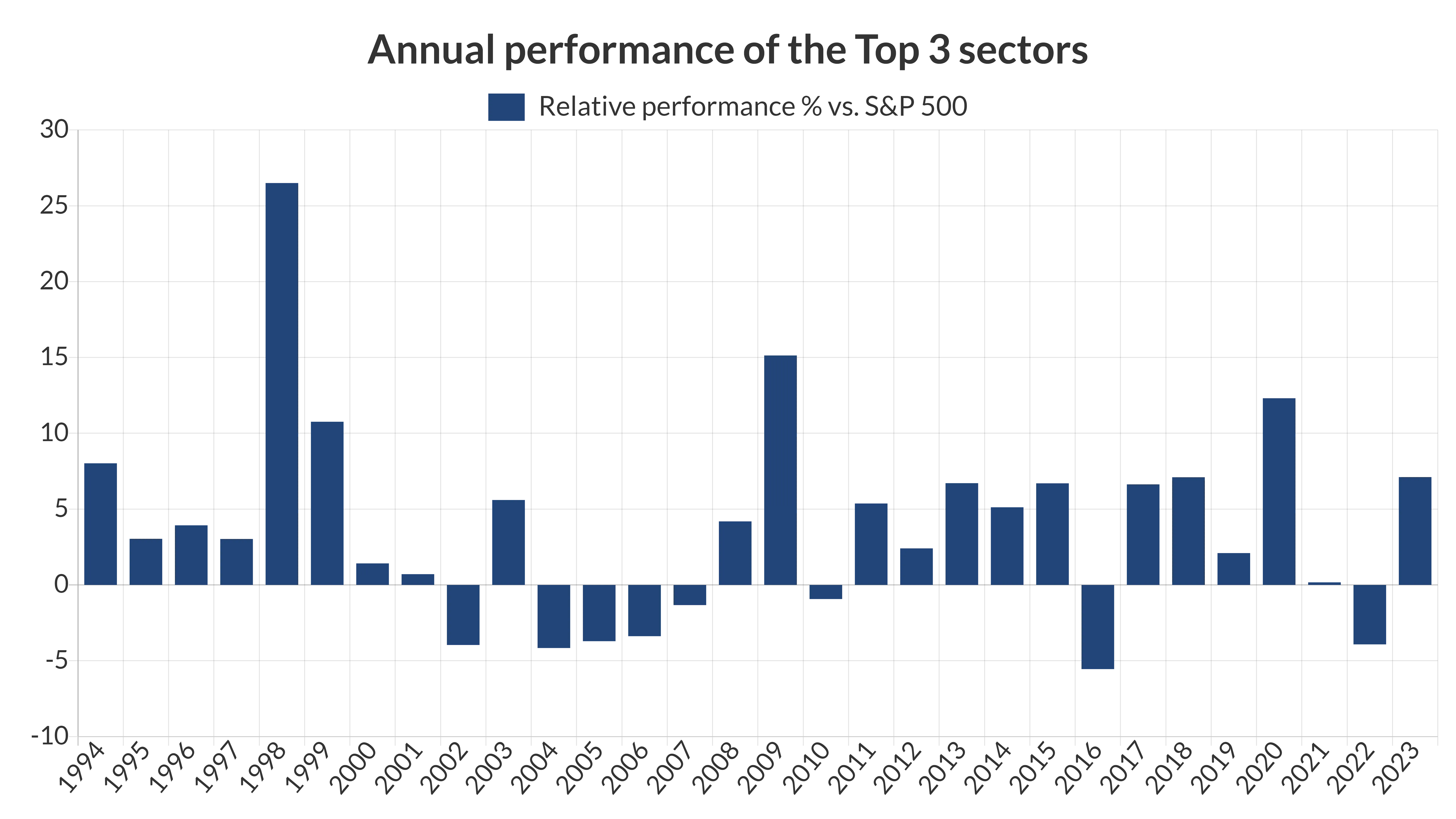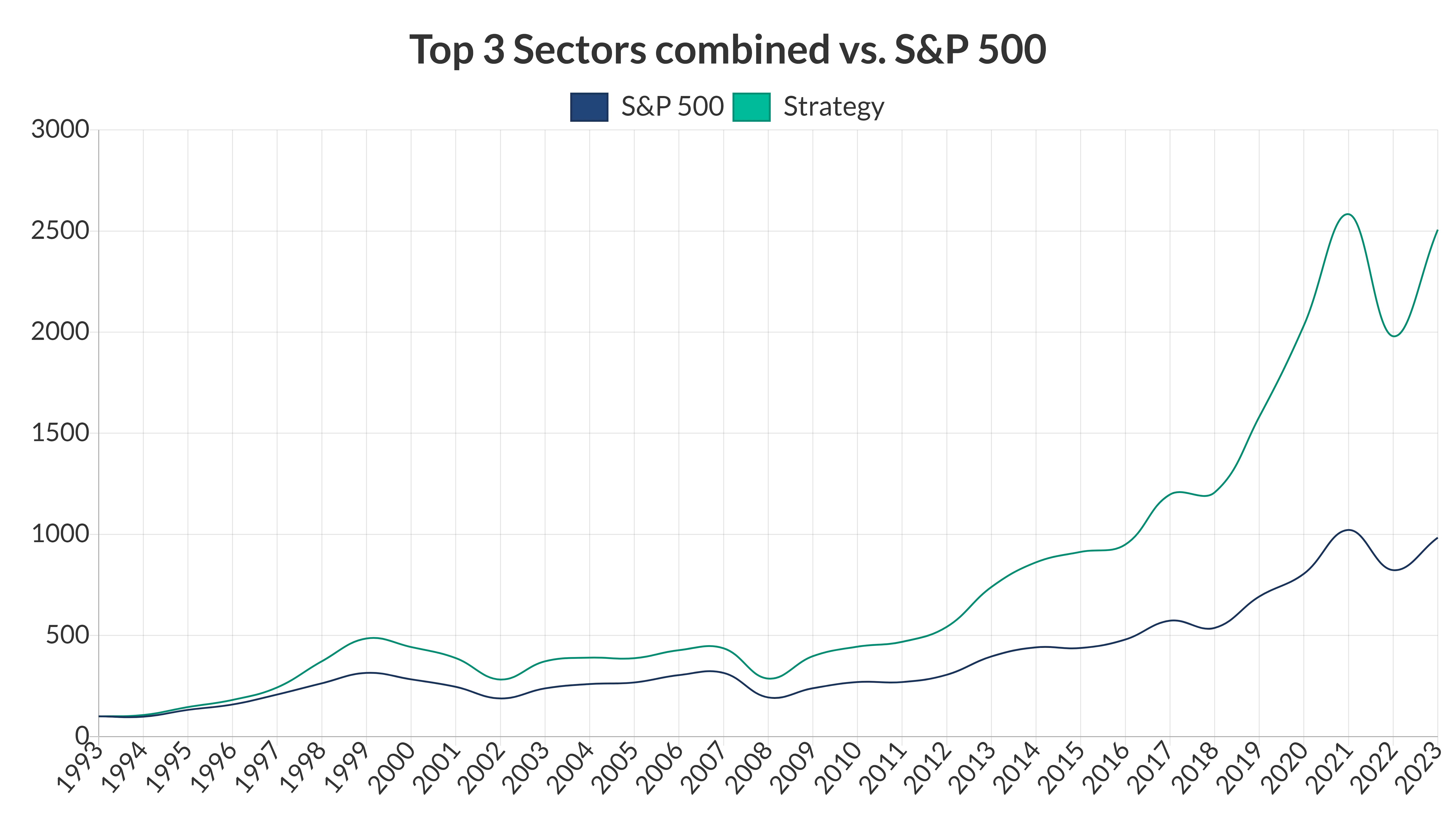The Simple Sector Strategy That Beats the Market in the Long Run

You may have noticed that stocks tend to follow their sectors (to some extend at least) going up and down. One year it's all about technology stocks and the next year, before you know it, energy stocks is the place to be. But have you ever wondered if it would be reasonable to focus on certain sectors for long term investing? This is what this post is all about.
The historical performance of sectors
For this analysis I will be looking at the S&P 500 sectors, which all the S&P 500 stocks are categorized into. The table below shows all the sectors and their average annual performance over the last 30 years, starting from 1993:
| Sector | Annual return | Relative vs. S&P 500 |
|---|---|---|
| Communication | 2.74% | -5.24% |
| Consumer Discretionary | 8.99% | 1.01% |
| Consumer Staples | 7.14% | -0.84% |
| Energy | 6.48% | -1.50% |
| Financials | 6.05% | -1.93% |
| Health Care | 9.58% | 1.60% |
| Industrials | 7.70% | -0.28% |
| Information Technology | 12.11% | 4.13% |
| Materials | 5.73% | -2.25% |
| Real Estate | 4.22% | -3.86% |
| Utilities | 4.13% | -3.85% |
Notice how only three sectors have outperformed the total S&P 500 index over the 30 year period, while the remaining sectors have lagged.
Are consumer staples no good anymore?
A lot of great investing textbooks claim that consumer staples have historically given the highest returns, especially when considering risk and reward. This is also true when looking at old data, and consumer staples really did perform well until the late 1990'es. However, as the table shows, the sector has been lagging the S&P 500 when looking at data from the last 30 years. I believe this period is a better indicator of returns in the near future, than data from the 20th century, but there are of course no guarantees.
Consistency of the best sectors
When I find a strategy that has done well over a long time frame I'm always curious about how systematic and consistent the outperformance has been. If there are large ups and downs on the road, I will be less inclined to hold on to the investment.
I will now focus on the three sectors that outperformed the general market over the full 30 years:
- Information Technology
- Health Care
- Consumer Discretionary
The table below shows their relative performance vs. the S&P 500 index each year:

There's no doubt that Information Technology has by far been the best sector bet over the past 30 years, but it comes with serious drawbacks and extended periods of underperformance compared to the S&P 500.
But more interestingly, the data also shows that the sectors tend to excel at different times and one sector often weigh up the loss of another. For instance Health Care lagged the index by more than 31% in 1999, but at the same time the technology stocks smashed the index by an astonishing 58.91%. In the following year the tech stocks lagged the index by more than 30%, but this was again more than offset by Health Care, which beat the S&P 500 by 45.68%!
Combining sectors for a smooth ride
When a loss in one investment is outweighed by another, it's the power of diversification. And when diversifying between a number of outperforming assets, you may be in for something good.
So in order to get the most out of this, I tried combining the three winning sectors. The strategy is straightforward: Put one third of your investable money into each of the three sectors. Rebalance at the beginning of each year to make sure each sector still makes up one third. This wipes out the bad drawdowns and sets you up for a smooth ride, while still outperforming the S&P 500.
The consistency of the strategy is illustrated by the relative performance vs. S&P 500 by year:

Let's draw some conclusions on the results of the combined portfolio:
- It beats the S&P 500 in 22 of the 30 years
- The worst year was 2016 where it lagged the index by 5.55%
- The best year was 1998 where it beat the index by 26.5%
- The CAGR was 11.34% vs. 7.98% of the S&P 500
The last part is the most important. The CAGR (Common Average Growth Rate) was more than 3% higher than the index. How is this possible, when the average of the three sectors did not achieve this number, you may ask? The secret is in the rebalancing. When rebalancing each year to retain the equally sized positions, you will automatically be buying more of the sectors that had a bad year. As they tend to go up and down, this buying behavior improves the returns in the long run.
Finally the performance chart for the strategy looks like this compared to the S&P 500:

Looking at it this way, the results are more impressive than I had imagined. The power of compounding really does wonders over a long time frame, even when the alpha (the performance above market level) was "only" 3.36% annually. An initial investment of $1,000 at the beginning in 1993 would look like this:
| Investment | Value in 1993 | Annual return | Value in 2023 |
|---|---|---|---|
| Sector strategy | $1,000 | 11.34% | $25,070 |
| S&P 500 | $1,000 | 7.98% | $9,838 |
How to invest with this strategy
This strategy can be seen as an alternative to the usual passive investing where you simply buy an S&P 500 index fund or ETF. The strategy is very easy to implement using ETFs that track the individual sectors:
US listed ETFs
- Technology Select Sector SPDR (XLK)
- Health Care Select Sector SPDR (XLV)
- Consumer Discretionary Sector SPDR (XLY)
ETFs listed in Europe
- iShares S&P 500 Information Technology UCITS ETF (QDVE)
- iShares S&P 500 Health Care UCITS ETF (QDVG)
- iShares S&P 500 Consumer Discretionary UCITS ETF (QDVK)
Can we expect similar performance in the future?
The answer is obvious: You never can. In investing there are no guarantees, and future returns may be completely different from what was seen in the past. However, two things make me optimistic that the trend could continue:
- The consistency of the outperformance has been quite significant and has shown no signs of abating in recent years.
- From a fundamental perspective it seems somewhat intuitive to me that the fastest development and progress will continue to happen in these sectors for decades to come - especially in Information Technology and Health Care.
But regarding the last point we're moving towards speculation, which I generally try to avoid. Never expect yourself to be wiser than the pros, unless you have really good reason to ;-)